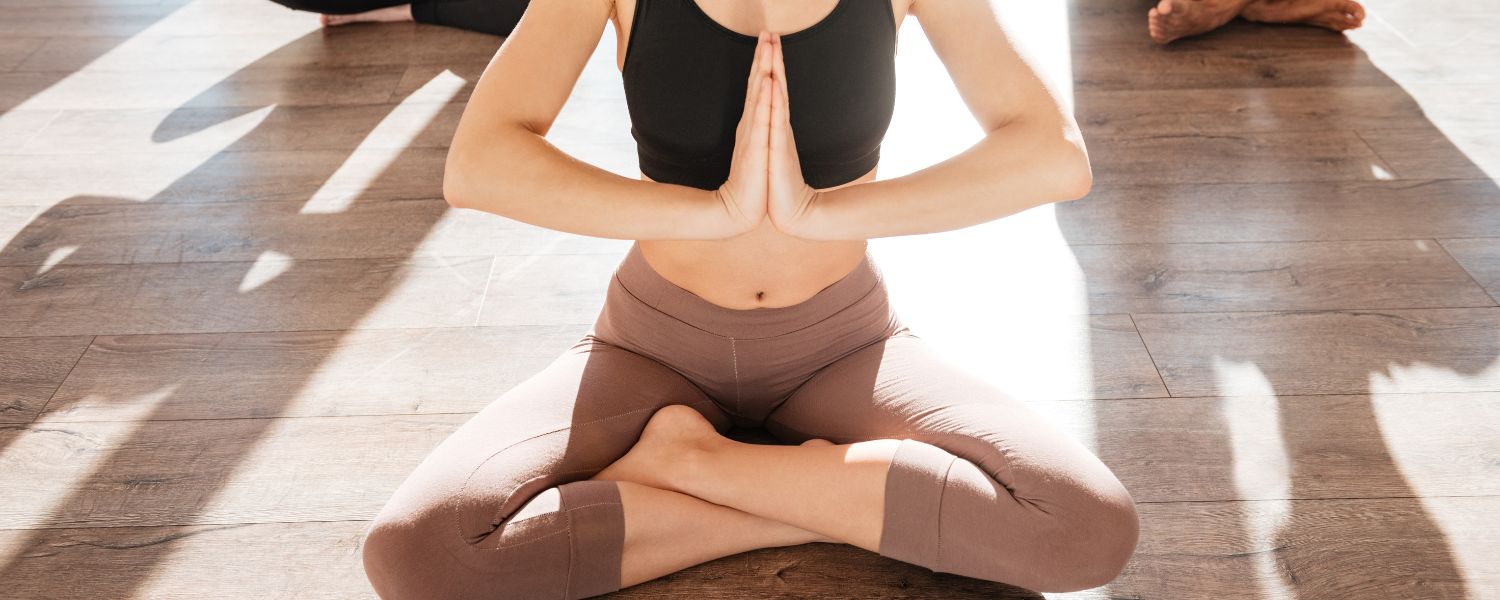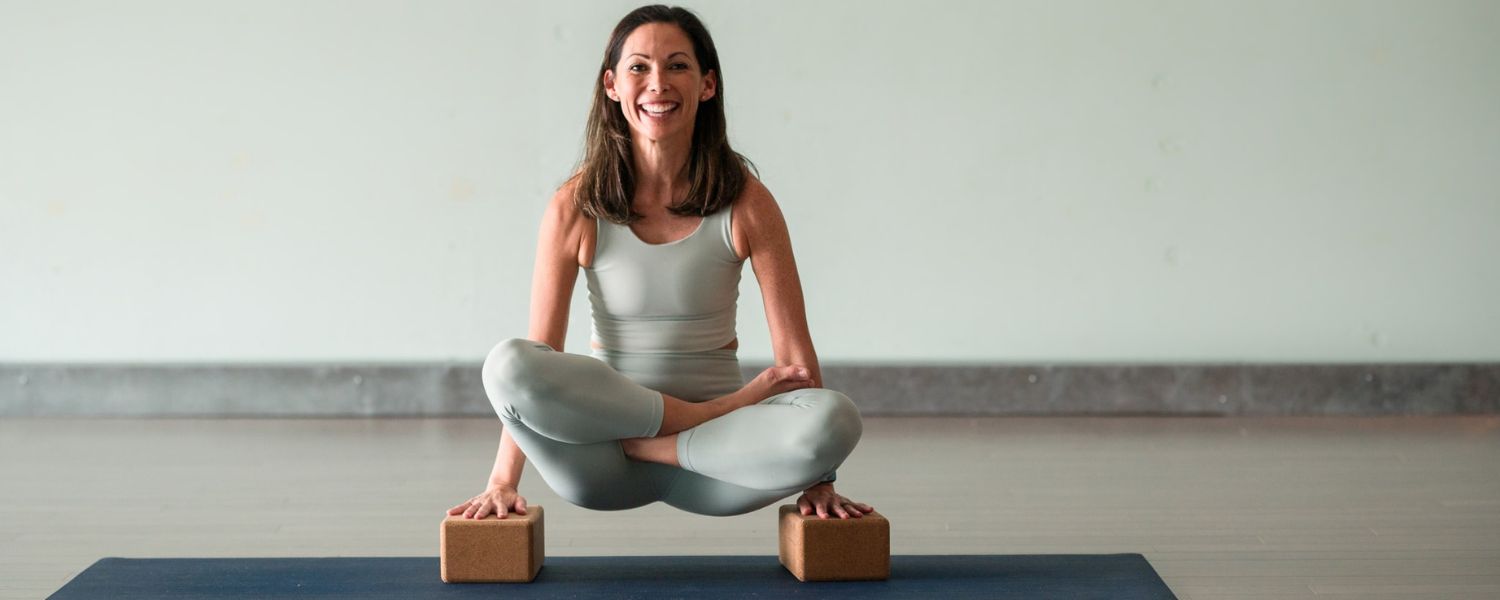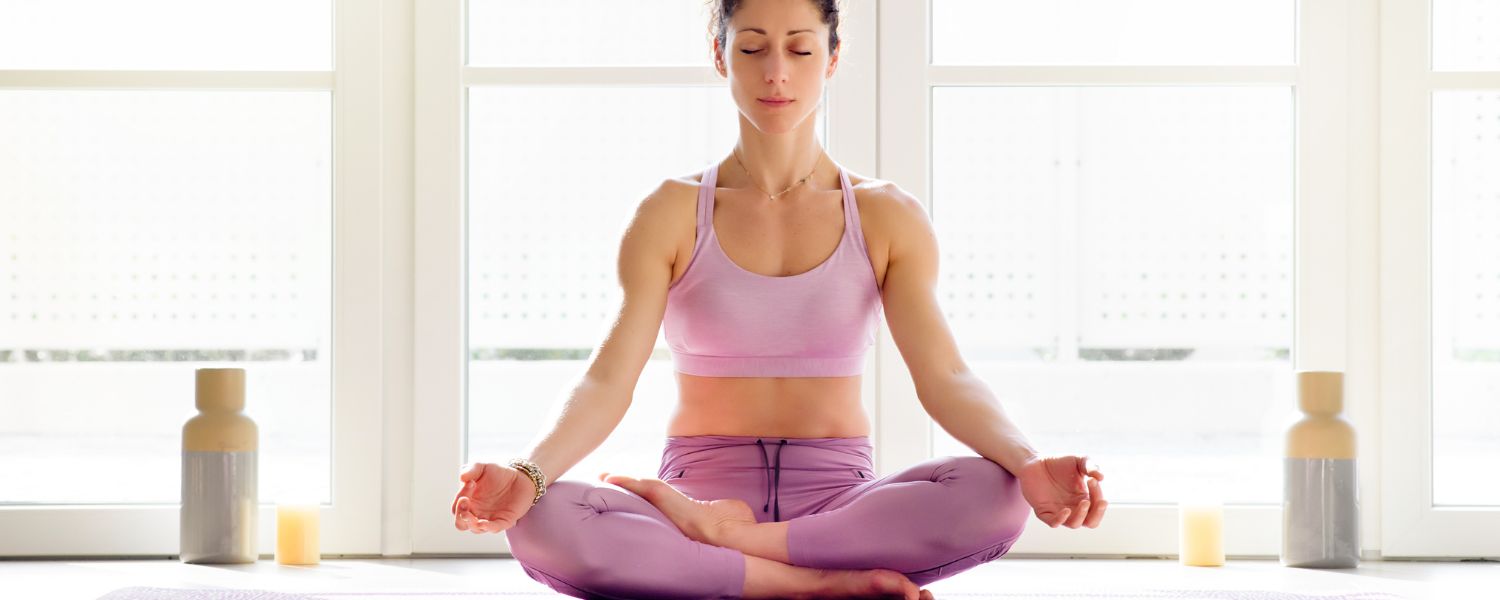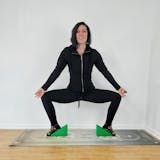Lotus pose, known as "Padmasana" in Sanskrit, is a revered posture in yoga practice.
It symbolizes enlightenment and inner peace. While the primary form of Lotus Pose is widely practiced, there exist advanced variations that can further enhance your yoga journey.
This guide will delve into these variations, uncovering their benefits and offering practical insights for incorporating them into your practice.
Sanskrit Meaning of Lotus Pose
The Sanskrit term for Lotus Pose is "Padmasana." It's composed of two words "Padma," which translates to lotus, and "Asana," meaning posture or seat. So, Padmasana literally means the posture resembling a lotus flower.
Just like a lotus flower unfolds its petals gracefully, this pose involves folding the legs similarly, symbolizing inner peace and enlightenment.
Lotus Pose Benefits
Lotus poses, or Padmasana, offer a range of benefits for both the body and mind.
1. Enhanced Flexibility
Regular practice of Lotus Pose increases flexibility in the hips, knees, and ankles. The posture involves deep external rotation of the thighs, which can help loosen tight muscles and improve joint mobility.
2. Improved Posture
Sitting in Lotus Pose requires a straight spine and engaged core muscles. Over time, this could lead to enhanced posture not only during yoga sessions but also in your daily activities, reducing the likelihood of encountering back pain and discomfort.
3. Stress Relief
The meditative aspect of Lotus Pose, coupled with controlled breathing (pranayama), promotes relaxation and reduces stress. It calms the mind, soothes the nervous system, and encourages a sense of inner peace.
4. Stimulated Energy Flow
Practicing Lotus Pose is believed to facilitate the flow of prana, or life force energy, throughout the body. This can help balance the chakras (energy centers) and promote overall vitality and well-being.
5. Mental Clarity and Focus
Holding Padmasana requires concentration and mindfulness. As you focus on your breath and body alignment, developing mental clarity enhances your concentration, offering valuable benefits for your daily activities.
6. Hip Opening
Lotus Pose intensely stretches the hip flexors, groin, and piriformis muscles. This can relieve tension and tightness in the hips, which is especially beneficial for people who spend extended periods sitting or have sedentary lifestyles.
7. Spiritual Connection
In yoga philosophy, the lotus flower symbolizes purity, enlightenment, and spiritual growth. By practicing Padmasana, practitioners may cultivate a deeper connection to their inner selves and the universal consciousness.
How to Do Lotus Pose
Here's a step-by-step guide on how to practice Lotus Pose (Padmasana)
1. Sit Comfortably
Start by positioning yourself on the floor with your legs stretched out in front of you. Ensure you maintain a straight posture, elongating your spine, and activate your core muscles to support your lower back.
2. Bend Your Right Knee
Flex your right knee and draw your right foot towards your left hip crease. Position the sole of your right foot upwards, ensuring the heel is near your pubic bone.
3. Bend Your Left Knee
Afterward, flex your left knee, drawing your left foot toward the crease of your right hip. The sole of your left foot should face upward, and your heel should be close to your pubic bone. Both knees should ideally touch the ground.
4. Adjust Your Position
If you find bringing both feet onto opposite hip creases challenging, you can start with Half Lotus Pose. In the Half Lotus pose, one foot rests on the opposite thigh, while the other leg remains extended.
5. Align Your Spine
Once your legs are in position, ensure that your spine is straight and your shoulders are relaxed. You can place your hands on your knees, palms facing upward or in a mudra position.
6. Engage in Breathing
Take slow, deep breaths as you hold the pose. Concentrate on extending both your inhalations and exhalations, letting your breath lead you further into the pose.
7. Hold the Pose
Stay in Lotus Pose for a few breaths, or for however long it feels right. If any discomfort or pain arises, gently ease out of the pose and settle back into a comfortable seated position.
8. Release with Care
To release the pose, carefully straighten your legs and extend them in front of you. Shake out your legs and take a moment to notice any sensations in your body.
Remember to approach Lotus Pose with patience and mindfulness, honoring your body's limitations and avoiding any forceful movements. Regular practice and gentle persistence can gradually deepen your experience of this sacred posture.
Beginner Tips
For beginners, practicing Lotus Pose (Padmasana) can be challenging. Here are some tips to help you ease into the posture safely and comfortably.
1. Start Slowly
If you're new to yoga or have tight hips, start by practicing Half Lotus Pose. This variation involves placing one foot on the opposite thigh while extending the other leg. You can gradually progress to the full Lotus Pose as your flexibility improves.
2. Use Props
Don't hesitate to use props such as cushions, yoga blocks, or folded blankets to support your hips and knees. Adding a cushion or block beneath your knees can ease pressure and enhance the accessibility of the posture.
3. Listen to Your Body
Pay attention to how your body feels in the pose. If you experience any discomfort or pain, especially in your knees or ankles, gently release the pose and try a modified version. Straining yourself excessively may result in injury, so it's important to respect your body's boundaries.
4. Warm-Up
Before attempting Lotus Pose, warm up your body with gentle stretches and movements. Concentrate on loosening your hips and stretching your inner thighs to ready them for the deeper hip opening needed for Padmasana.
5. Practice Mindful Breathing
As you hold the pose, focus on your breath. Take slow, deep breaths, and allow your breath to guide you deeper into the posture. Practicing mindful breathing can effectively soothe your mind and ease tension in your body, enhancing your comfort in the pose.
6. Be Patient
Flexibility takes time to develop, so be patient with yourself as you work towards achieving Lotus Pose. Progress gradually, and celebrate your achievements along the way, no matter how small they may seem.
7. Consistency is Key
Practice Lotus Pose regularly to improve your flexibility and comfort in the posture. Incorporate it into your daily yoga routine, even if it's just for a few minutes each day. With consistent practice, you'll gradually notice improvements in your flexibility and overall comfort in the pose.
Teacher Tips
As a yoga teacher guiding students through Lotus Pose (Padmasana), here are some helpful tips to ensure a safe and effective practice:
1. Emphasize Proper Alignment
Stress the importance of proper alignment in Lotus Pose. Encourage students to sit up tall with a straight spine and engage their core muscles to support their lower back. Remind them to keep their shoulders relaxed and their chest open.
2. Offer Modifications
Recognize that not all students will have the flexibility to practice Lotus Pose right away comfortably. Provide modifications and variations to accommodate students with different levels of flexibility. For example, suggest Half Lotus Pose or offer the use of props like cushions or blocks to support their hips and knees.
3. Encourage Breath Awareness
Guide students to focus on their breath as they hold the pose. Encourage slow, deep breathing to help them relax into the posture and release any tension or resistance. Remind them that the breath is their anchor, guiding them deeper into the present moment.
4. Provide Gentle Adjustments
Offer gentle adjustments to help students find the proper alignment in Lotus Pose. Use verbal cues and hands-on assistance to guide them into a comfortable and sustainable position for their bodies. Always ask for their consent before making adjustments, and respect their boundaries.
5. Incorporate Mindfulness Practices
Integrate mindfulness practices into your teaching, emphasizing the meditative aspect of Lotus Pose. Encourage students to cultivate a sense of presence and awareness as they hold the posture, noticing sensations in their body and observing their thoughts without judgment.
6. Offer Variations and Progressions
Challenge more advanced students by introducing variations and progressions of Lotus Pose, such as One-Legged Lotus Pose (Eka Pada Padmasana) or Eight-Angle Pose (Astavakrasana). Provide clear instructions and demonstrations to guide students safely through these advanced variations.
7. Create a Supportive Environment
Foster a supportive and inclusive atmosphere in your yoga classes, where students feel comfortable exploring their practice and expressing their needs. Encourage open communication and invite questions or concerns about Lotus Pose or any other aspect of the training.
Variations in Lotus Pose
Lotus Pose (Padmasana) offers several variations to challenge and deepen your practice.
Here are some variations to explore:
1. Half Lotus Pose (Ardha Padmasana)
This variation is a gentler version of Lotus Pose. Sit with one foot on the opposite thigh while the other remains extended. This variation is excellent for beginners or those with limited hip flexibility.
2. One-Legged Lotus Pose (Eka Pada Padmasana)
In this variation, one foot is placed in Lotus Pose while the other leg remains extended. This variation requires greater hip flexibility and can help improve balance and concentration.
3. Bound Lotus Pose (Baddha Padmasana)
This variation involves binding the hands behind the back while in Lotus Pose. This can help open the shoulders and chest while deepening the hip stretch.
4. Lotus in Shoulder Stand (Padma Sarvangasana)
In this variation, the legs are brought into Lotus Pose while in Shoulder Stand (Sarvangasana). This version of the pose necessitates a blend of strength and flexibility and is best learned under the supervision of a seasoned instructor.
5. Lotus in Headstand (Padma Sirsasana)
Similar to the previous variation, this variation involves bringing the legs into Lotus Pose while in Headstand (Sirsasana). This variation requires advanced strength and flexibility and should be practiced with caution.
6. Lotus in Lotus (Padmasana in Padmasana)
For an advanced challenge, try bringing both legs into Lotus Pose while sitting in Lotus Pose. This requires deep hip flexibility and a strong core.
7. Revolved Lotus Pose (Parivrtta Padmasana)
In this variation, twist the torso towards the bent knee in Lotus Pose. This variation helps to improve spinal mobility and digestion.
Why We Love This Pose
Lotus Pose (Padmasana) holds a special place in the hearts of yogis for several reasons.
1. Symbolism
The lotus flower symbolizes purity, enlightenment, and spiritual growth in many cultures, including yoga philosophy. Similar to how the lotus flower rises from murky waters to blossom into beauty, engaging in Lotus Pose can represent the path of metamorphosis and internal enlightenment.
2. Physical Benefits
Lotus Pose offers a wide range of physical benefits, including improved flexibility in the hips, knees, and ankles, enhanced posture, and reduced tension. The gentle compression of the lower abdomen in Lotus Pose can also stimulate digestion and promote overall abdominal health.
3. Mental Relaxation
Practicing the Lotus Pose promotes deep breathing and mindfulness, aiding in calming the mind and alleviating stress and anxiety. This meditative posture nurtures inner peace and tranquility, enabling individuals to reconnect with themselves and achieve balance in the face of life's trials.
4. Spiritual Connection
Lotus Pose represents a sacred and deeply spiritual experience for many practitioners. By sitting in this posture, individuals may feel a sense of connection to their higher selves, the universe, or a divine source. It can be a substantial tool for introspection, self-discovery, and spiritual growth.
5. Accessibility
Despite its profound symbolism and spiritual significance, Lotus Pose is accessible to practitioners of all levels. With patience, practice, and proper guidance, anyone can gradually progress towards achieving this posture. The variations and modifications of Lotus Pose make it adaptable to individual needs and abilities.
7. Cultivation of Patience and Discipline
Mastering Lotus Pose requires dedication, perseverance, and patience. As practitioners work towards deepening their practice, they develop qualities such as discipline, focus, and self-awareness, both on and off the mat.
8. Community and Tradition
Lotus Pose has been practiced for centuries and is deeply rooted in the tradition of yoga. By practicing Lotus Pose, individuals join a global community of yogis who share a common goal of self-discovery, growth, and well-being.
Preparatory and Counter Poses
Preparatory and counter poses are essential elements of a well-rounded yoga practice, helping to prepare the body for more challenging postures and restore balance afterward. Here are some preparatory and counter poses that complement Lotus Pose (Padmasana)
Preparatory Poses
1. Bound Angle Pose (Baddha Konasana)
This seated pose opens the hips and inner thighs, preparing them for the deeper hip opening in Lotus Pose. It also stretches the groin and stimulates the abdominal organs.
2. Hero Pose (Virasana)
Hero Pose stretches the thighs, knees, and ankles, preparing them for the flexion required in Lotus Pose. It also helps improve posture and digestion.
3.Cow Face Pose (Gomukhasana)
This seated pose stretches the hips, thighs, and shoulders, making it an excellent preparation for Lotus Pose. It also helps improve flexibility in the arms and shoulders.
Counter Poses
1. Child's Pose (Balasana)
After practicing Lotus Pose, Child's Pose offers a mild stretch for the lower back, hips, and thighs. It promotes relaxation and helps release tension in the spine.
2. Supine Spinal Twist (Supta Matsyendrasana)
This reclined twist releases tension in the spine and stretches the hips and lower back. It's an excellent counter pose for Lotus Pose, helping to neutralize the spine and restore balance.
3. Downward-Facing Dog (Adho Mukha Svanasana)
Downward Dog lengthens and stretches the entire body, including the spine, hamstrings, and calves. It releases shoulder and neck tension, making it a beneficial counter pose for Lotus Pose.
Conclusion
Incorporating advanced variations of Lotus Pose into your yoga practice can elevate your journey toward physical and mental well-being.
By embracing the challenges and rewards presented by these differences, you can enhance your comprehension of both yourself and your work.
Remember to approach each variation with patience, mindfulness, and respect for your body's limits.
As you continue to explore and evolve, may the essence of Lotus Pose guide you toward greater harmony and balance in life.
Green Apple Activewearoffers a comprehensive range of yoga clothing and accessories designed to elevate your practice and enhance your comfort.
Whether looking for the perfect yoga mat and shoulder strap for easy transport or stylish leggings like the New Mya Legging - Black Dove or the Estelle Fitted Flare - Black Beauty, Green Apple Activewear has you covered.
Their dedication to excellence and sustainability radiates in each item, guaranteeing that you not only appear stylish but also feel confident about your decisions.
With innovative designs and eco-friendly materials, Green Apple Activewear is a brand you can trust to support your yoga journey.
So why settle for anything less? Experience the difference with Green Apple Activewear and take your practice to new heights of style and sustainability.














